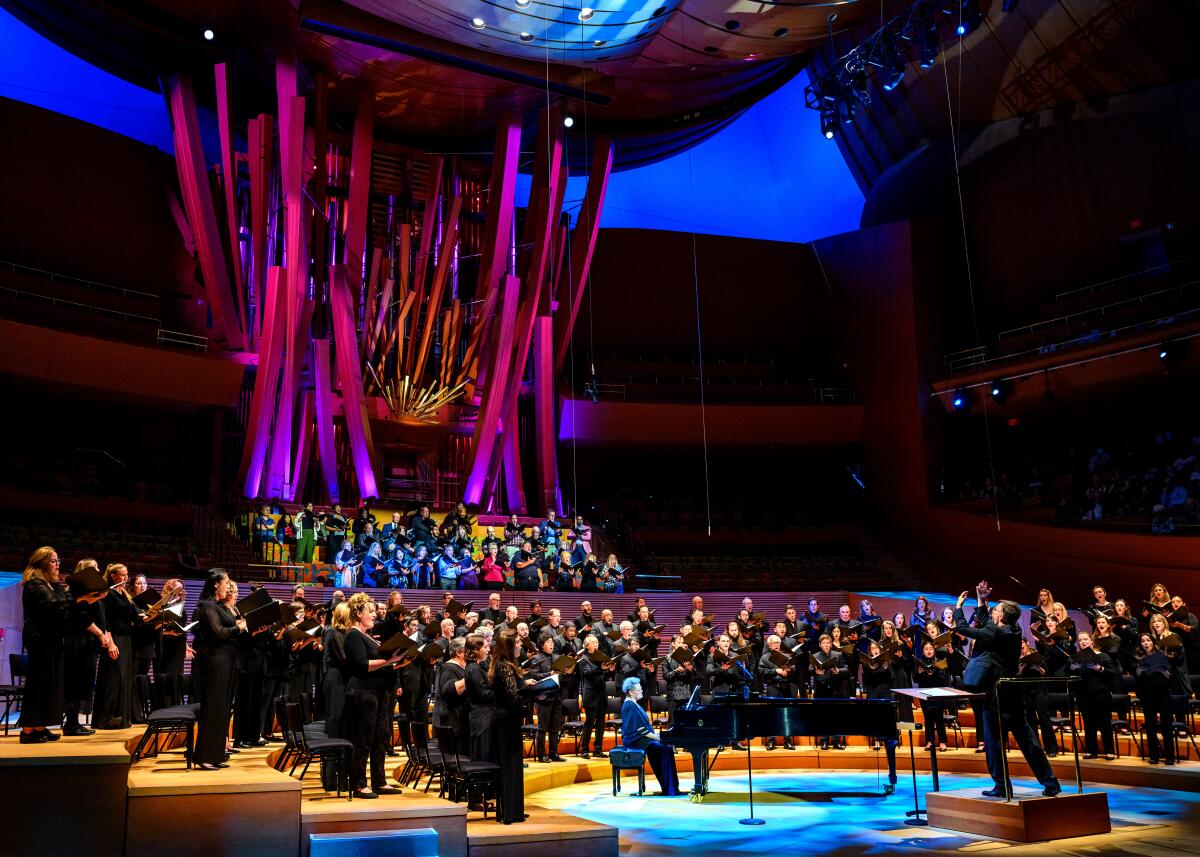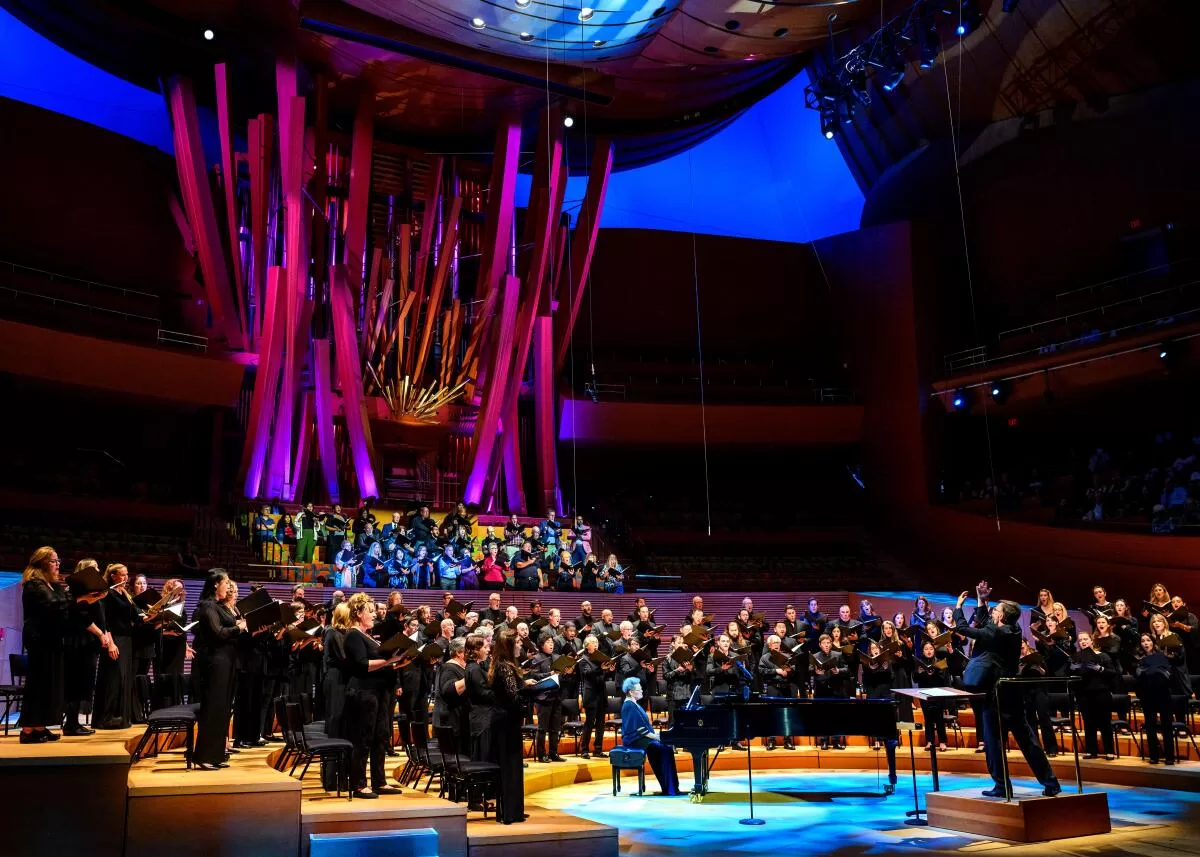When Gustavo Dudamel became music director of the Los Angeles Philharmonic 15 years ago, the ensemble had already under Esa-Pekka Salonen become the orchestra of the future, playing far more new music than another in America. Dudamel’s response was to commission and premiere even more. His first gala began with the premiere of John Adams’ huge symphony, “City Noir.” The next night, for his first regular subscription concert, he premiered Unsuk Chin’s “Su.” With that he began a tradition of beginning each season with a premiere that has had huge ramifications for L.A. and beyond.
This year, though, the L.A. Phil gala was not, as it had been for over a half-century, an October surprise. The program paired Lang Lang as soloist in Rachmaninoff’s potboiler Second Piano Concerto with the full score to Ginastera’s ballet “Estancia,” a Dudamel favorite that he has performed complete in Walt Disney Concert Hall and in excerpts at the Hollywood Bowl over the last two years. But Dudamel lived up to tradition by opening the season with the premiere of a major cello by Gabriela Ortiz and a new staging of Mendelssohn’s “A Midsummer Night’s Dream,” featuring Spanish film star María Valverde.
Presumably the reason for the same-old, same-old gala (which I missed to hear Julia Bullock perform “Harawi”) was that this week Dudamel and the orchestra were in New York to present the same gala program for Carnegie Hall’s fancy opening night. That might seem more daring for a big fundraiser in a town where Ginastera’s wonderful ballet is little known. Meanwhile, the New York Philharmonic will catch up with the 15-year-old “City Noir” when Adams conducts it next month.
In fact, two years before Dudamel takes over at the New York Philharmonic, Dudamel-mania reached New York with three L.A. Phil concerts at Carnegie. Following the gala were a repeat of the Ortiz-”Midsummer” program (Ortiz is Carnegie’s composer-in-residence this season) and the concert he gave with Natalia Lafourcade at the Bowl last month. The L.A. Phil will take all three programs, dominated by Latin American music, to Bógata, Colombia.
Dudamel and Ortiz have developed a particularly close relationship. Two recent L.A. Phil commissions — a violin concerto, “Altar de Cuerda,” and the ballet “Revolución Diamantina,” have just been released as recordings by the orchestra and are major contributions to new music.
“Dzonot,” Ortiz’s new cello concerto written for Alisa Weilerstein, takes its title from the Mayan word for abyss. In mythology, it refers to both the source of life and the entrance to the murky underworld. The concerto is full of sonic imagery that travels above and below ground, down to the rivers in deep caverns and up in the skies to the environmentally threatened toh bird.
The solo cello does not stand out in the way the violin does in “Altar de Cuerda.” Instead, Weilerstein seems to serve as part of the weird Mayan underground, with its mysterious gods and beasts. In one movement, she becomes the enchanted voice of a jaguar; in another she channels the song of the toh. The rainforest envelopes all, the orchestra percussion rich and curious.
This is an intriguing fit with “A Midsummer Night’s Dream,” directed by Dudamel’s longtime collaborator, Alberto Alvero. The production centers on Valverde, who read lines of different characters in a Spanish translation of Shakespeare. Fleet, flitting here and there, in front of the orchestra and behind, her Puck seems to become the toh bird. Bottom as represented in Mendelssohn’s overture is jaguar-like. The vocal music — which featured Jana McIntyre, Deepa Johnny and the Los Angeles Master Chorale — is sung in the original English.
Arvelo writes in his program note about his fascination with cultural transformations: what happens to Shakespeare spoken in Spanish, what happens to “Midsummer” interpreted by a German composer, what happens to the play when it inspires painters from different eras and cultures (paintings were projected overhead), what happens when Hollywood gets it imaginative hands on things (clips from Max Reinhardt’s 1935 classic were included).
Much of this flew by, especially if one tried to read the English surtitles. Where to look? What to listen for? What’s what? The L.A. Phil sounded brilliant. Disney was lighted to be a wonderland. Valverde, who is Dudamel’s wife, intoned as might a magician. More translations came in the transferring of this program from Disney to the formal, old-school resonant, Carnegie.

Grant Gershon conducts the Los Angeles Master Chorale at Walt Disney Concert Hall in a celebration of the chorus’ 60th anniversary.
(Jamie Phan / Los Angeles Master Chorale)
That the L.A. Master Chorale took part was significant. The chorus has but a small part in Mendelssohn’s score but brought more magic. Such luxury casting, though, was hardly affordable for the L.A. Phil tour.
Plus the Master Chorale had been occupied with something of its own, celebrating its 60th anniversary three days later at Disney. The chorus and the L.A. Phil have an essential partnership. The Master Chorale was founded by Rodger Wagner to be a companion resident company at the Dorothy Chandler Pavilion, which was built for the L.A. Phil and opened Dec. 6, 1964.
Although the Music Center doesn’t thus far seem to be giving this anniversary much attention, the Master Chorale had a special program Sunday of 22 short, mostly a cappella pieces that ranged from the 16th century to the present. They were meant to show the range what has become, under Grant Gershon, one of the most versatile, to say nothing of the finest, choruses in America.
There is little the chorus can’t do. It has been an essential institution on its own and in its collaborations with the L.A. Phil. This time there was no Philip Glass or Meredith Monk or Steve Reich or Nico Muhly or other composers Gershon has championed in his transformative 23 years as music director.
Instead, there were small pieces, quite a few by little-known composers, along with Bruckner motets, bits of Tchaikovsky and Rachmaninoff and Bernstein. It would have been unlikely that anyone other than Gershon had heard of all the composers, the likes of Juan Gutiérrez de Padilla (1590-1664) or Robert Lucas Pearsall (1795-1856). The music of the late Elinor Remick Warren, whom Dorothy Chandler commissioned to write the chimes theme for her pavilion, made a welcome appearance.
Yet this long, obscure miscellany turned out to be a garland of little gems. Little was major or important, but each one was special, capable of reminding us that the sound of this chorus in Disney is a splendor to be encountered nowhere else.
